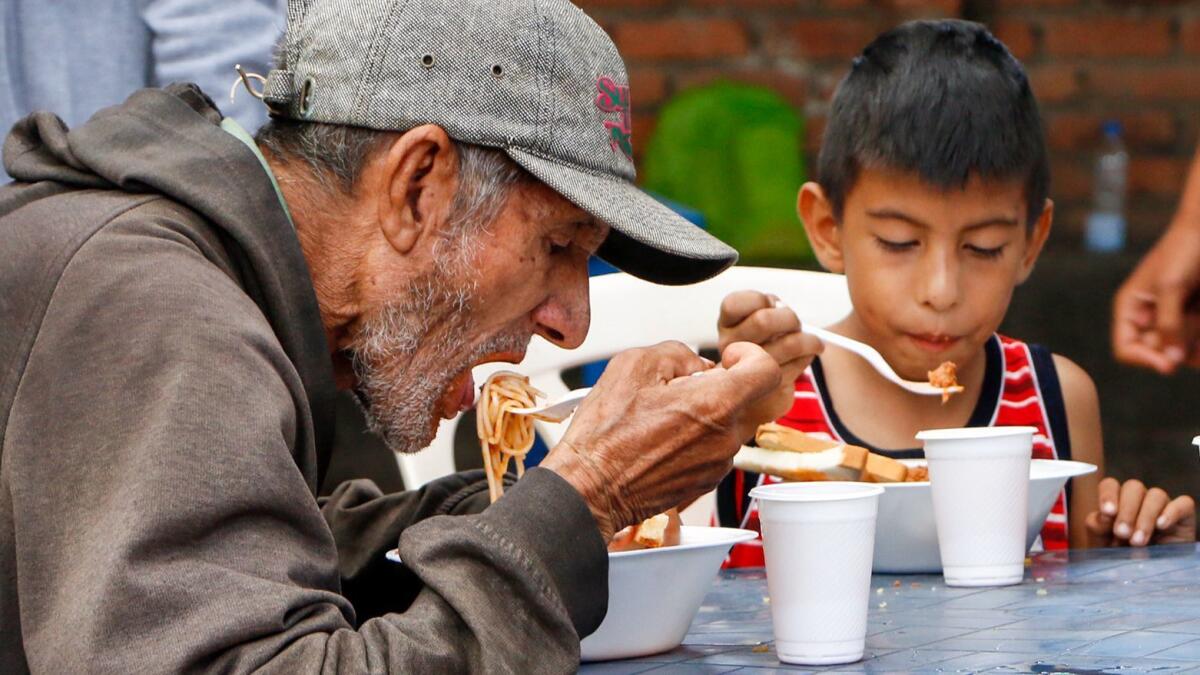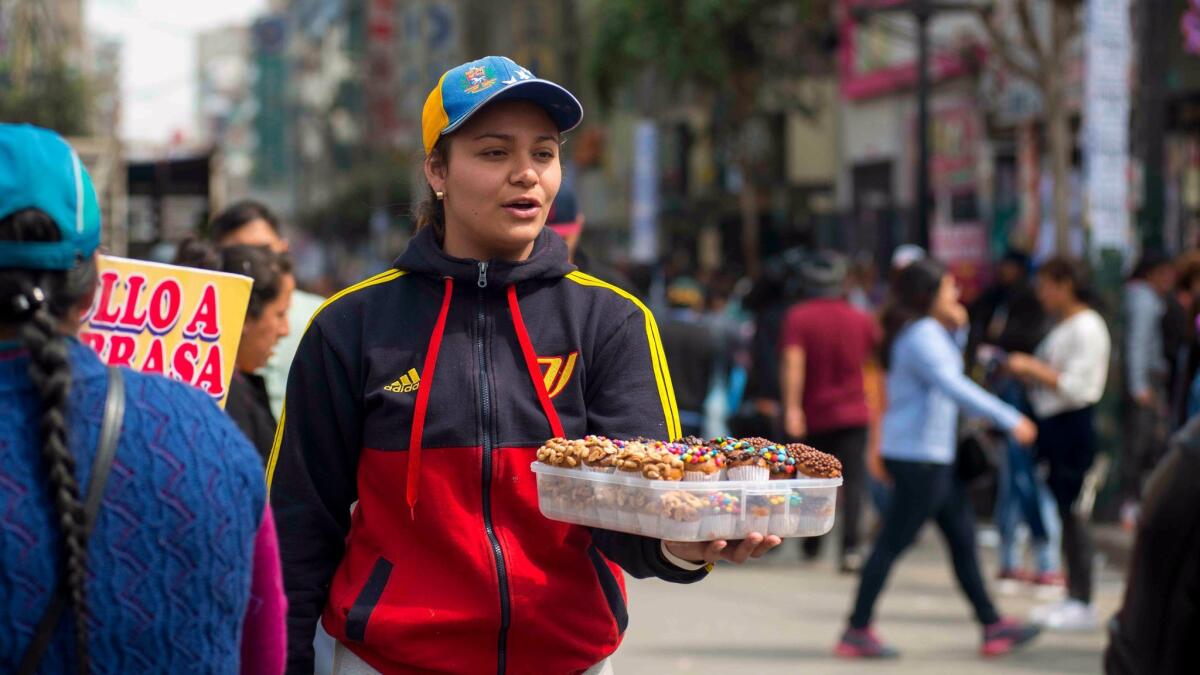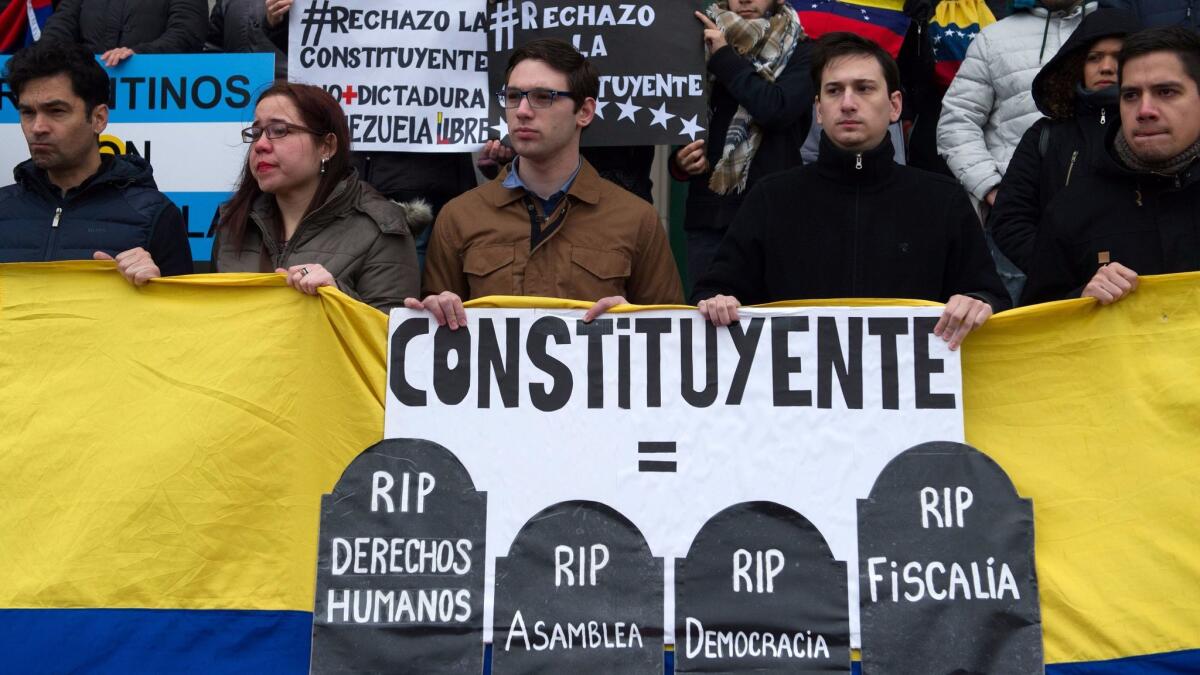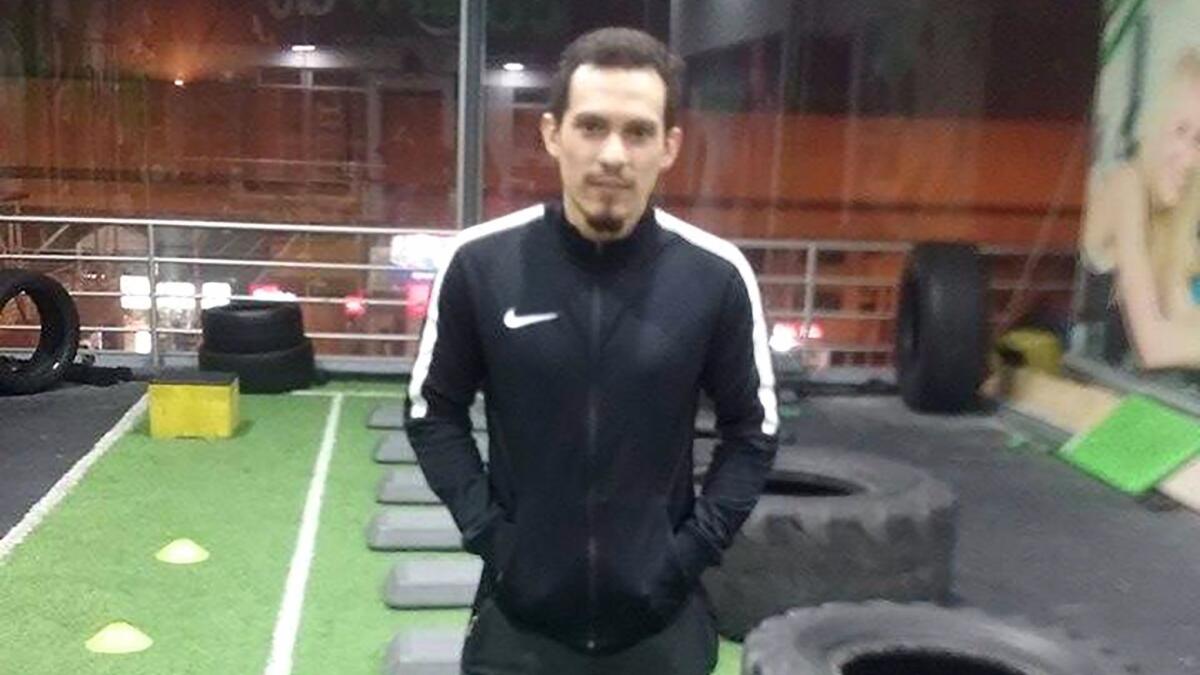Driven by unrest and violence, Venezuelans are fleeing their country by the thousands

As Ana Linares ambled around Lima’s sprawling and historic Plaza San Martin, holding aloft a tray of pastries, her shouts pierced the rush hour traffic roar: “Donuts, fresh donuts!!” She earns about $15 a day — more than she made in a month in her native Venezuela.
“It’s enough to live on and even send a little cash back to my family in Barquisimeto,” Linares said between sales. She buys the pastries from a Venezuelan neighbor and hustles downtown to the plaza. “I don’t leave until I’ve sold them all.”
Linares arrived in Lima last May after enduring a six-day bus trip from central Venezuela, her 8-month-old son on her lap, to join her husband who came months before. Life in Venezuela had become intolerable, with millions struggling with hyperinflation, food shortages, lack of work and lawlessness.
“Everything there has turned ugly. There’s hunger and crime. You can’t leave your house after 5 p.m. because you’re going to be robbed or killed,” Linares said, adding that she now earns enough to afford three meals a day, an impossibility for many these days in Venezuela.
“I miss my mother, my house and at times I feel out of place here, like in someone else’s home,” Linares said. “But Peru has opened its doors to us.”
Linares is part of the rising tide of Venezuelan immigrants washing over Latin America as conditions at home steadily worsen. Arrivals in Peru have roughly doubled since last year and more than 20,000 Venezuelans have either applied for or received a special residency permit since the government began offering them in February.

Similar year-on-year percentage increases in arriving Venezuelans have been reported in Ecuador, Panama and Chile. Argentina’s migration officials say applications for temporary and permanent residence permits are on track to more than triple.
For many Venezuelans, leaving was simply a matter of survival. Since the late President
The country continues to be roiled by political unrest, with government critics accusing President
With Venezuela’s economy collapsing, the exodus shows no sign of abating, although the Venezuelan government is making it more difficult for those leaving by slowing passport processing to a virtual standstill, said Tomas Paez, a sociology professor at Central University of Venezuela, an expert on the widening diaspora that now extends over 94 countries.
“You have all ages, all professions, persons of all education levels leaving Venezuela,” Paez said, adding that as many as 500,000 Venezuelans have fled their country in the last two years and a total of 2.1 million since 1998.
Over the last two decades, the U.S. and some European countries, such as Spain and Italy, have each taken in far more Venezuelans than Latin American nations, with the exception of neighboring Colombia. But the flows in this hemisphere now are increasing at a faster rate because of less red tape and easier means of arrival, Paez said.
Panama is among the handful of Latin and Caribbean countries that have made it harder for Venezuelans to gain entry. After arrivals there reached 4,770 over the first seven months of 2017, already double the full-year 2016 total, Panama began requiring that all arriving Venezuelans have formal visas.
But Latin American countries — so far at least — generally are reciprocating Venezuela’s decades-long receptivity to immigrants from all over the world. Here are snapshots of some countries receiving higher flows of Venezuelan immigrants.
Argentina
Temporary and permanent resident visas issued to Venezuelans will reach nearly 40,000 this year, up from 12,800 in 2016, according to projections issued by Argentina’s national migration department. The expected visas to be issued just this year will equal those handed out over the entire previous decade.
Acquiring a permanent residence permit is relatively easy, and the convenience was decisive for Luis Pulido, formerly a journalist based in Caracas, who chose Argentina over the U.S. and Dominican Republic. He arrived in March of last year and now works two jobs, waiting tables during the day and teaching college journalism at night.
“It’s no secret what’s happening in my country, especially since 2013, that the deterioration of Venezuela has accelerated,” Pulido said, adding that his entire family has abandoned Venezuela. His mother was the last to leave, joining him in Buenos Aires in March.
“I don’t feel totally uprooted because I stay on top of things, the news of what is happening day to day,” Pulido said. “But I feel the physical separation from those I left behind . And I constantly worry about the friends and family who suffer the violence, the scarcity of food and medicine. It’s my country and it hurts, and I suffer for those living there.”

Chile
Like many recent Venezuelan arrivals, Adelso Pena, 28, had experienced his share of pain and sorrow before finally deciding to leave his homeland. He said his girlfriend died needlessly in March because she couldn’t get medications to treat her rare autoimmune disorder.
“The hardest thing I lived through in Venezuela was seeing people die because they couldn’t get the pills they needed,” said Pena, who worked as a financial analyst for a cement company. He arrived in Santiago in July.
He hopes to get a permit to allow full-time work soon, and in meanwhile is working part time at a coffee shop owned by Venezuelans and living with relatives. He has noted that his countrymen are becoming increasingly visible on the streets of the Chilean capital.
“You walk down the streets and one in every 10 persons you see is Venezuelan,” Pena said, adding that most appear to have college degrees.
Police figures indicate that over the first seven months of 2017 around 45,000 Venezuelans came to Chile with the intention of staying, more than double the 20,000 for all of 2016. With its strong economy and relatively low unemployment rate, Chile is an attractive destination, said Gabriela Cabellos, spokeswoman for the Chilean immigration department.
“Chile looks on the map as a safe country with institutional stability and job opportunities,” Cabellos said.
Cabellos noted that Chile and Venezuela developed many ties during another turbulent time: during the rule of Augusto Pinochet from 1973 to 1990. For Venezuelans, those ties are proving valuable today.
“During the dictatorship, many people left Chile and were received in Venezuela, so there are [immigrants] with relatives in Chile and so that is a factor” driving immigration, Cabellos said.

Colombia
The flow of immigrants between Venezuela and Colombia traditionally has swung back and forth, according to Migration Colombia director Christian Kruger. When Venezuela’s oil-based economy is humming along, Colombians flood in to supply the manpower that the domestic labor force cannot provide. As many as 1.1 million Colombians lived and worked there during boom times a decade ago.
Now that times are tough in Venezuela, with oil revenue, jobs and democracy in decline, the pendulum is shifting toward Colombia.
According to latest estimates, between 300,000 and 400,000 Venezuelans now live in Colombia. But how many are recent arrivals is hard to determine, although officials estimate the incoming volume has roughly doubled this year from last.
Along the porous 1,400-mile border, multitudes of day-trippers cross from Venezuela to shop, and trips made to maintain business and family connections make precise statistics hard to pin down.
But there is little question that masses of Venezuelans are fleeing their country. As of July 31, more than 632,000 Venezuelans had registered for a “Border Mobility Card” introduced by Colombia earlier this year.
The cards give the bearer permission to transit freely in Colombia for two years. How many carriers intend to stay indefinitely is impossible to measure.
Also complicating efforts to compare 2017 flows with last year is the fact that Venezuelan authorities had shut down the common border with Colombia for an entire year — August 2015 to August 2016.
When Venezuela reopened the border, as many as 40,000 per day crossed over to Colombia, mostly to buy food and medicines and return home. But many also left their country for good.

Ecuador
Eduardo Febres Cordero, 32, a former Venezuelan consular official from Maracay, decided to stay in Quito, Ecuador’s capital, after resigning in 2011 and marrying an Ecuadorean woman. He says President Maduro “betrayed” the socialist revolution begun by his predecessor, Hugo Chavez, whom he served as a student leader.
An energetic entrepreneur, Cordero now works in public relations and runs a Facebook page entitled Venezuelans in Ecuador-Quito that claims more than 100,000 members, many of them recent arrivals.
Many Venezuelans new to Ecuador don’t know where to turn when they have a legal or medical problem. So Cordero, noticing that 9 of every 10 Venezuelans arriving have professions or trades, formed a foundation called Funvex that connects the growing Venezuelan diaspora with doctors, lawyers, computer specialists and other service personnel in exile in Ecuador and other countries. “There is a lot of solidarity,” he said.
The Venezuelan community is expanding rapidly. Ecuadorean interior ministry statistics indicate that over the first half of 2017 there was a net inflow (arrivals minus departures) of 22,000 Venezuelans, or nearly equal to the 24,000 who came during all of 2016. If that pace continues, immigration this year could reach 44,000, or four times the 2015 total.
Cordero said he has experienced xenophobia or anti-Venezuelan attitudes in Quito but that generally he feels welcome. “It’s better than being Venezuela,” Cordero said. “If Maduro were to fall tomorrow, I figure it would take Venezuela 15 years to recover.”

Peru
Peru especially has put out the welcome mat for Venezuelans. In February , it began issuing 1-year residence visas known as PTPs that allow Venezuelans to work and study hassle-free. Peru’s open-door policy has been lauded by the U.N.’s human rights commission as an exemplary humanitarian example that should be followed by the rest of the region.
“The situation in my country forced me to leave. The deteriorating economy, the government’s violence — it’s horrible what’s happening,” said Ignacio Jose Cardosa, a strapping 28-year-old who works as a trainer at a health club in a middle-class barrio of Lima.
The Caracas native is an electrical engineer by profession, so his leggings and tank top aren’t his usual workplace attire. But after arriving by bus in July, hungry and broke, he was happy to land whatever job he could get.
He blames Venezuelan President Maduro for the chaos. “People ask me if I will return someday, and I want to cry because I never wanted to leave. But I’m furious that Maduro is still there doing so much damage.”
Cardosa, whom his clients describe as good natured and popular, is appreciative of the Peru’s welcome and the work opportunities. “I went through some tough days waiting to receive my work permit. But now I have a good job and make enough to get by in Lima. For me, that’s a luxury.”

Special correspondents Leon and Kraul reported from Lima and Bogota, Colombia, respectively. Also contributing were special correspondents Andres D’Alessandro in Buenos Aires; Jorge Poblete in Santiago, Chile; Pablo Jaramillo Viteri in Quito, Ecuador, and Mery Mogollon in Panama City, Panama.
ALSO
Pro-government candidates dominate Venezuelan election; opposition cries foul
Trump meets with Puerto Rican governor: 'I give ourselves a 10'
Plans to rebuild hurricane-ravaged Barbuda reignite a decades-old land dispute
Start your day right
Sign up for Essential California for news, features and recommendations from the L.A. Times and beyond in your inbox six days a week.
You may occasionally receive promotional content from the Los Angeles Times.



